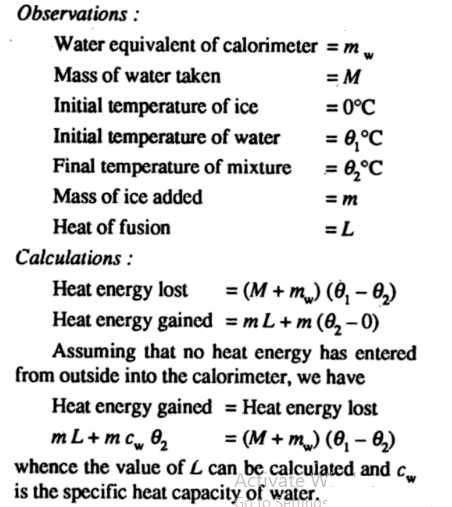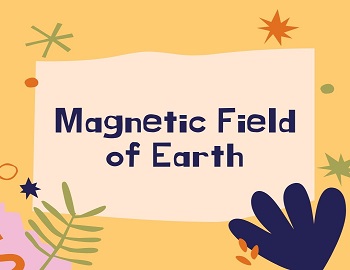Table of Contents
Heat of Fusion:
When heat is added to a solid, the solid warms up and a thermometer placed in contact with it shows a rise in temperature. However, when the temperature reaches the melting point, even though heat continues to be added, no further rise in temperature is recorded by the thermometer till the whole mass of the substance has melted. What happens to the heat added during melting?
The heat supplied during melting is in fact used to bring the change of state of the substance from its solid state to the liquid state.
The amount of heat energy required to melt the unit mass of a given substance at its melting point is known as the specific heat of fusion of the substance.
The specific heat of fusion is written by the symbol L. If Q is the amount of heat energy required to melt a mass m of the substance, then obviously
| Q =mL |
The specific heat of fusion for ice is 80 cal g-1, which means that 80 cal of heat energy is required to meet 1 g of ice at 0°C. The specific heat of fusion can also be expressed as 80 kcal kg-1. The SI unit of the specific heat of fusion is J kg-1 and in terms of this unit, the specific heat of fusion of ice is 336000 J kg-1.
Explanation on the basis of the Kinetic Model:
As heat is added to a solid, the vibrations of atoms become more vigorous. Though no change is visible, most of the crystals expand and the heat added increases the average kinetic motion of the particles. Since temperature is an indication of the average kinetic energy, the temperature of the solid increases with the addition of heat energy.
At the melting point, the vibrations become so energetic that any added heat serves to loosen the binding process that keeps an ordered array, thus the substance gradually changes its state and becomes liquid. During the process of melting whatever heat is added, it is spent in doing work against the binding forces. Consequently, the added heat does not go to increase the average kinetic energy but increases the potential energy instead. As there is no change in the average kinetic energy, the substance stays at the same temperature during melting.
Determination of Heat of Fusion of Ice:
Apparatus: Heat of fusion of ice can be determined by using an ordinary calorimeter.
Method: In order to determine the heat of fusion of ice, a calorimeter is nearly half-filled with water and its temperature is noted. Now some pieces of ice are dried with the help of blotting paper and dropped into the water of the calorimeter.
The water is stirred well, keeping the pieces of ice always underwater. The lowest temperature reached by the mixture is noted. The calorimeter with its contents is weighed several times to know the mass of the calorimeter, the mass of water taken, and the mass of ice added.

Errors and Precautions:
- The pieces of ice before dropping should be carefully dried with blotting paper.
- During stirring, the pieces of ice should always be kept underwater.
- Use a sensitive thermometer.
- The amount of ice added should be small otherwise the complete mass of ice added may not melt.
Consequences of High L of Ice: The heat of fusion of ice is 80 cal g-1 or 336000 J kg-1 which is quite high compared to the heat of fusion of other common substances. The following are the consequences of higher heat of fusion of ice:
- Lakes, rivers, etc., do not freeze suddenly, because for each kg of water to freeze, 336000 joules of heat must be removed. The heat so liberated moderates the temperature of the atmosphere and slows down the process of freezing.
- For the same reason, snow on mountains melts slowly. Consequently, the rivers contain water practically for the whole year.
- Soft drinks are cooled by ice instead of cold water. This is because every kilogram of ice will extract 336000 joules of heat energy more than water at 0°C.
- Fruit and vegetable merchants keep tubs of cold water around fruits and vegetables to protect them from damage due to sub-zero temperatures. As the water of the tub starts freezing, it gives out about 336000 joules per kilogram which dissipates into the surrounding air.
- As snow starts meeting, it becomes bitterly cold.









Comments (No)